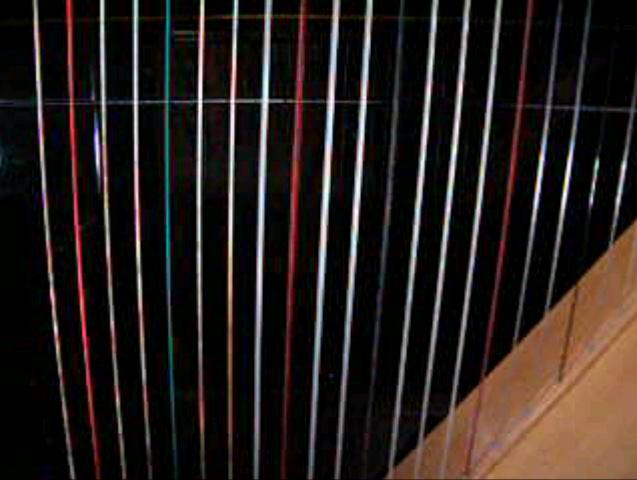ASA/CAA '05 Meeting, Vancouver, BC



Harp Design and Construction
Chris Waltham waltham@physics.ubc.ca
Department of Physics & Astronomy
University of British Columbia
Vancouver BC, Canada V6T 1Z1
Popular version of paper 5aMU8
Presented Friday morning, May 20th, 2005
ASA/CAA '05 Meeting, Vancouver, BC
Construction
The harp is triangular in shape. The easiest part of the triangle to
make is the post (fig. 1), as it plays little part in the sound
production and
can therefore be over-engineered; the compressional force is in any
case
mostly axial. The neck has to withstand the total tension of all the
strings, and also a large torque, as all the strings are mounted on one
side. The curvature does not help, and as much of the characteristic
grace and
elegance of a harp derives from the neck shape, it cannot be overbuilt.
Very strong many-layered plywood seems to be the best material, covered
with veneer for beauty's sake. The soundboard has to be both thin
(note how floppy it is), and also to withstand all the string tension
(6000N in this case - more than half a ton). Sitka spruce is the
material of choice, for its acoustical properties and anisotropic
strength. The grain runs horizontally, and thin veneer with vertical
grain is applied to prevent
cracking (although it degrades the sound slightly). The soundbox is a
light, hollow shell, with holes at the back
for improved sound radiation and access to the strings. The whole
structure bends alarmingly under the string tension (and occasionally
explodes), so the veneer has to be very well bonded.
| Figure 1: Construction Sequence |
|||||
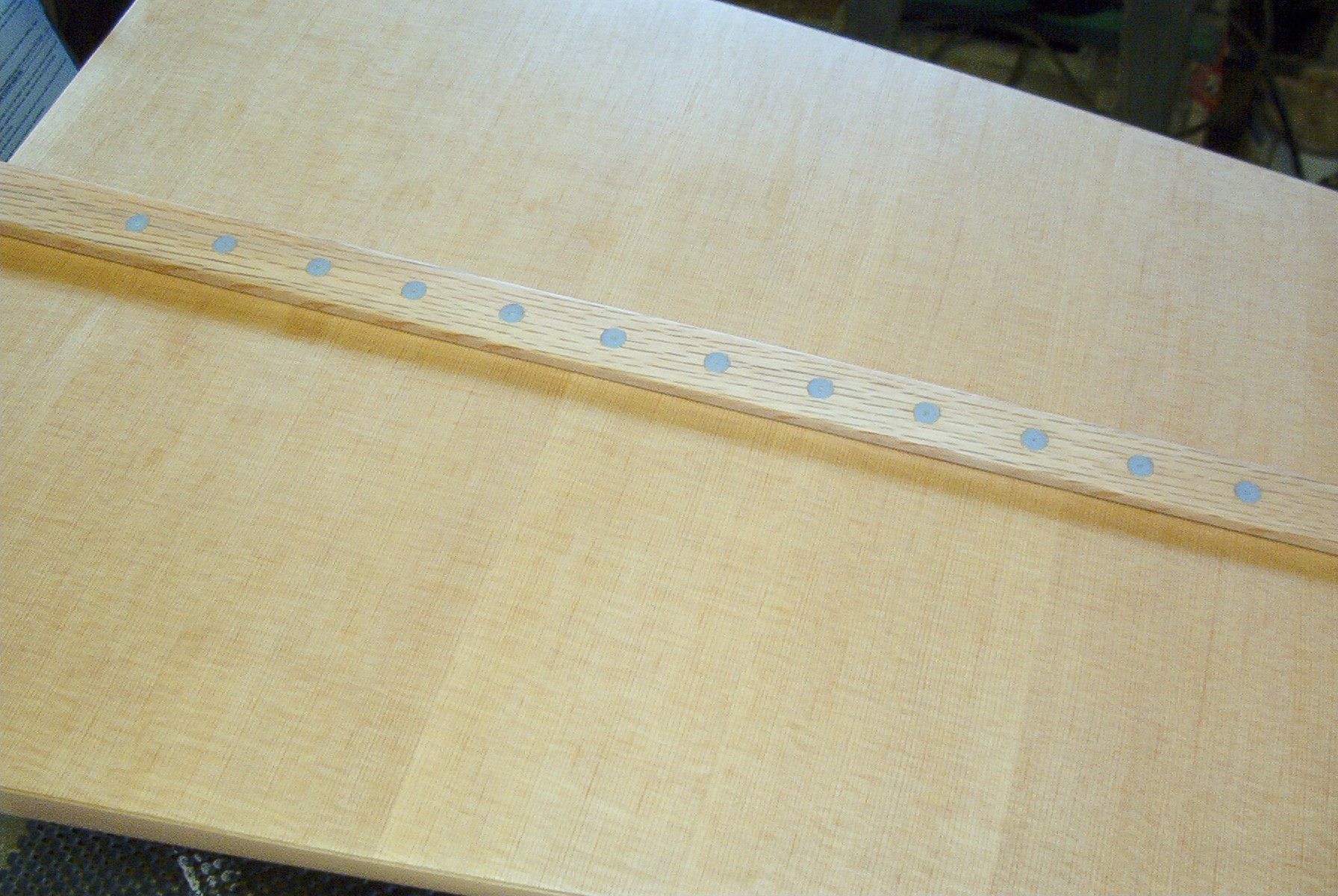 |
|||||
| Post capital
and base on lathe (birch) |
Mortising
the post capital |
Neck (baltic birch ply, birch/maple veneer) |
Soundboard (sitka spruce) |
Soundbox (birch/maple veneer on "rubber" ply) | String
support (oak and nylon) |
The Finished Product
In the following panel I have placed my own celtic and lever harps
in the context of harp evolution (fig. 2). The harp has been
basically
triangular-shaped for about 1000 years. The gothic harps had small,
thick soundboxes and soundboards carved out of two solid pieces of
wood, and needed "brays" to buzz against the strings and increase the
sound output. Larger, more efficient soundboards came with the celtic
harps. In the renaissance, soundboards were made ever thinner,
especially in Spain. Chromatic tuning was achieved by having two or
three rows of strings, making the harps very difficult to play, and
multiplying the total force on the soundboard. Sharpening levers to
raise the pitch of the strings by a semitone went some way to solving
this problem. The ultimate "modern" concert harp was developed by Erard
in Paris and London around 1800; these had pedals attached to a complex
mechanism which could raise the pitch of the strings by one or two
semitones.
| Figure 2: Evolution of Harps |
|||||
| Small soundbox, thick soundboard |
Larger soundbox |
2,3 string rows: chromatic |
Levers for semitone
sharpening, thin soundboard |
Double-action pedals |
|
| Gothic Harp
(C15),Hofburg Museum, Vienna |
Homemade Celtic harp (18 strings) | Arpa a tre
file (1625), Museo Civico, Bologna |
Homemade
lever harp
(36 strings), copy of George Morley model (London, 1820) |
Erard Harp c.1800 (modern concert harp), Hofburg Museum, Vienna | |
Strings
The string material is determined by harmonicity (the overtones
should sound pleasant) and "feel" (fig. 3). Harmonicity requires that
the string
be strong, heavy enough, but not stiff. "Feel" is how hard the player
has to pull to move the string centre a given amount before release; it
should be large enough that the strings do not touch, and not vary too
much from string to string. Nylon or gut would probably suffice for all
strings if the lower strings followed the curve set by the upper
strings and became very much longer than they actually are. Gut is
mechanically similar to nylon but has a warmer tone for the
mid-register. Practical reasons make the harp neck a double curve (an
ogive, so it isn't too tall) and so much heavier strings are needed for
the low register. Nylon/gut strings would have to be very thick here,
very inharmonic, and the feel would be so small that the strings would
interfere with each other. Steel wrapped with helical copper wire is
used, although there is an awkward change in feel at the break.
| Figure 3: String data measured on a
Salvi Aurora Concert Harp |
|
 |
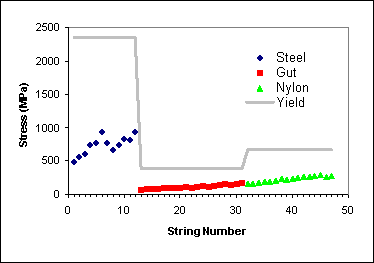 |
| Basic harp shape and position of
string types |
Maximum stress (and tension)
occurs in the steel strings |
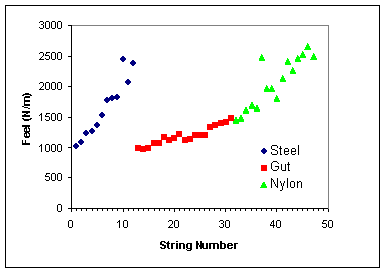 |
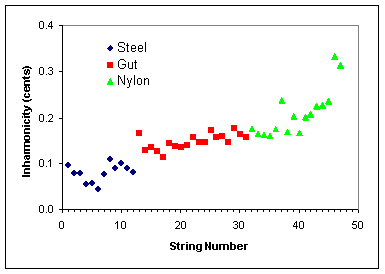 |
| The highest steel and nylon
strings feel the tightest to the player |
The steel keeps the
inharmonicity low for the lowest strings |
The Characteristic Sound of a Harp
- The string is plucked in the middle, which reduces even harmonics. In some music, the harp is sometimes plucked close to the soundboard in order to imitate a guitar.
- There is very strong coupling, via to soundboard, between any two
strings with overlapping overtones. In the case of a
large harp, many strings vibrate when only one is plucked; see figs. 4
and 5.
- The long strings vibrate in collapsing and expanding ellipses,
which gives many strings a long pulsed tail to the sound (fig. 6).
- The large number of strings allows for glissandi, a feature most people
immediately associate with the harp.
Not so easy is it? Even when you hear it - without visual clues - it is not completely obvious. Look at the spaces between the overtones; the harp has many faint spikes caused by other strings starting to resonate. There is very string one at 262 Hz from the C4 string (an octave and a minor third away - a factor of about 7/3).
- String motion data taken by Gary Chan, as part of his
undergraduate thesis work; thanks to Andrzej Kotlicki for the position
sensors.
- Thanks to the UBC Music Department for the loan of the Salvi
Aurora.
- The sonogram software was obtained from www.baudline.com.
- Harp plans from Robinson Harps, California.
